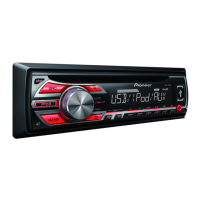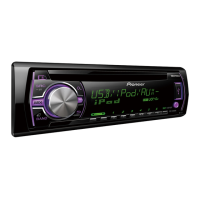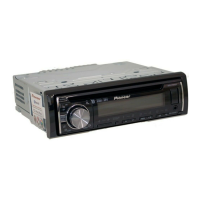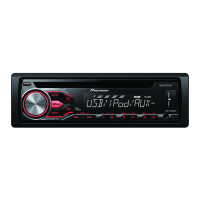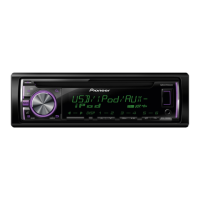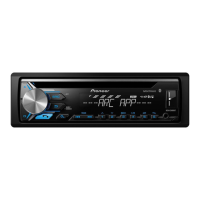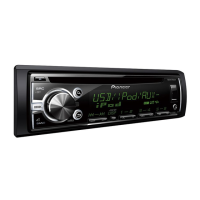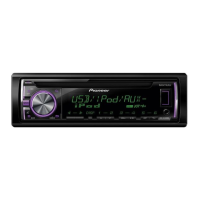Why is my Pioneer Car Receiver malfunctioning?
- LlhartmanJul 26, 2025
If your Pioneer Car Receiver is malfunctioning, it may be due to interference from nearby electrical devices. Try moving these devices away from the receiver.
Why is my Pioneer Car Receiver malfunctioning?
If your Pioneer Car Receiver is malfunctioning, it may be due to interference from nearby electrical devices. Try moving these devices away from the receiver.
What to do if my Pioneer Car Receiver says USB device consumes too much current?
If your Pioneer Car Receiver says that the connected USB storage device consumes more than the maximum allowable current, disconnect the USB storage device and do not use it. Turn the ignition switch to OFF, then to ACC or ON, and then connect only compliant USB storage devices.
What to do if my Pioneer Car Receiver says USB device not supported?
If the USB device is not supported by your Pioneer Car Receiver, ensure that you are connecting a USB Mass Storage Class compliant device. If the issue persists, disconnect the current device and replace it with a compatible USB storage device.
Why won't my Pioneer Car Receiver play files from my USB?
If your Pioneer Car Receiver does not play files, it might be because the connected USB storage device contains files embedded with Windows Media DRM 9/10. Try playing an audio file not embedded with Windows Media DRM 9/10 or transfer audio files not embedded with Windows Media DRM 9/10 to the USB storage device and connect it to the receiver.
What to do if repeat play range changes unexpectedly on Pioneer Car Receiver?
If the selected repeat play range changes unexpectedly on your Pioneer Car Receiver (when another folder or track is being selected, or during fast forwarding/reversing), select the repeat play range again.
What to do if my Pioneer Car Receiver displays no embedded text information?
If there is no embedded text information displayed on your Pioneer Car Receiver, switch the display or play another track/file.
Information regarding user modifications and their impact on equipment operation and rights.
Guidelines for safe operation, hearing protection, and warnings about potential hazards like proposition 65 chemicals.
Details regarding the unit's operation, frequency allocation for North America, and important notes.
Information on locating and recording the unit's serial number for security and convenience.
Explanation of abbreviations used in the manual for clarity, such as USB storage devices and iPod.
Information on contacting Pioneer for product support, updates, and service information via website and customer support.
Identification and description of parts for DEH-X3500UI/X35UI and DEH-2500UI models.
Identification and description of buttons and functions on the remote control.
General operations including adjusting volume, display, and functions using the unit's controls.
Explanation of indicators and states displayed on the unit's screen for various functions.
Guides on initial setup, including setting the clock and navigating menu options.
Important handling instructions for the front panel to prevent damage and ensure longevity.
Instructions for removing and re-attaching the front panel for theft protection and proper handling.
How to switch between different audio sources like Tuner, CD, USB, iPod, Pandora, and AUX.
Guidelines for using the remote control, including pointing, battery replacement, and handling precautions.
Procedures for navigating back through displays and lists in the unit's menu system.
Detailed guide on using the radio tuner, including band selection, tuning, presets, and display options.
Instructions for playing CDs, CD-Rs/RWs, and USB storage devices, including file selection and navigation.
How to use the MIXTRAX feature for music playback with sound effects and lighting.
Managing display modes, selecting tracks by name, using special buttons, and sound enhancement.
How to play songs, select tracks/albums, and use MIXTRAX with an iPod.
Switching between control modes (iPod/App/Audio) and browsing for songs on iPod.
Using special buttons, sound retriever, link play, and operating the iPod from the connected device.
Adjusting audio book playback speed and sound retriever settings.
Requirements, limitations, and basic operations for using the Pandora internet radio service.
Detailed guide on adjusting Fader, Balance, EQ settings, Loudness, and Subwoofer output.
Configuring clock, display information, AUX input, and source level adjustments.
Adjusting key colors, display colors, dimmer settings, and custom illumination.
Customizing MIXTRAX playback, flash effects, display options, and manual cut-in effects.
Configuring initial settings like SP-P/O MODE for speaker output and subwoofer connections.
Using the AUX input, switching display modes, and managing unwanted displays.
Overview of essential wiring connections, safety warnings, and important installation considerations.
Connecting the main unit, power cord, and optional amplifier for proper installation.
Specific instructions for connecting a subwoofer to the unit, including wiring and settings.
Instructions for DIN front-mount and rear-mount installation, including securing the unit and trim ring.
Steps for removing the unit from the dashboard and handling the front panel for security.
Guides for resolving common operational symptoms like display issues and playback problems.
Explanation of error codes encountered during operation and their corresponding causes and actions.
Detailed error messages for USB, iPod, and Pandora, along with solutions and handling guidelines.
Guidelines for safely handling discs and the player to prevent damage and ensure optimal performance.
Important notes and warnings regarding discs, USB storage devices, and iPod usage.
Details on compatibility for compressed audio formats (WMA, MP3, WAV) and media types.
List of compatible iPod models and important notes on USB storage device usage and partitions.
Explanation of file hierarchy examples and copyright information for audio formats and trademarks.
Comprehensive specifications for the unit, including general, audio, tuner, player, and CEA2006 compliance.
Details of the limited warranty, coverage, exclusions, and conditions for US and Canadian products.
Instructions on how to get warranty service, contact information, and dispute resolution procedures.
Details on what the warranty does not cover, implied warranties, and legal rights.
Procedures for obtaining warranty service in the USA and Canada, including dispute resolution.
| MP3 playback | Yes |
|---|---|
| Playback disc formats | CD audio |
| Audio formats supported | MP3, WAV, WMA |
| Supported radio bands | AM, FM |
| Preset stations quantity | 24 |
| Product color | Black |
| Disc types supported | CD, CD-R, CD-RW |
| Audio output channels | 4.0 channels |
| Equalizer bands quantity | 5 |
| Maximum power per channel | 50 W |
| Display type | LCD |
| Bluetooth | No |
| Line outputs (RCA) | 2 |
| Number of optical discs | 1 discs |

